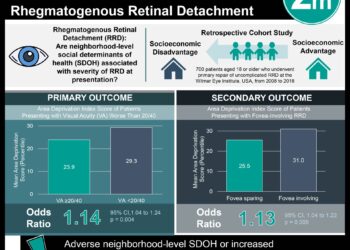Family resilience and neighborhood cohesion associated with improved health care use
1. Families including children with special health care needs (CSHCN) reported significantly lower odds of unmet health needs when they also reported high family resilience and neighborhood cohesion on surveys.
2. Reported material hardship was associated with higher odds of emergency department (ED) visits and unmet health care needs for all children. For CSHCN, neighborhood cohesion moderated the relationship between material hardship and ED visits.
Evidence Rating Level: 3 (Average)
Study Rundown: Material hardship, including lack of income, food, and housing, has been identified as a risk factor for adverse health outcomes. CSHCN, defined as children who have chronic medical conditions requiring health care services beyond what is typically needed, are likely at greater risk of adverse health outcomes in the context of material hardship. However, no previous studies have examined the potential association between material hardship, resilience factors, and health care use in CSHCN. In this cross-sectional study, researchers used national survey data from families with children and a household income of <200% of the federal poverty level to study the associations between material hardship, resilience factors (family resilience and neighborhood cohesion), and health care use (ED visits and unmet health care needs) in children with and without special health care needs. Material hardship was significantly associated with higher odds of both ED visits and unmet health care needs for all children. Both family resilience and neighborhood cohesion were associated with lower odds of unmet health care needs for CSHCN.
Though limited by an inability to distinguish between different types of special health care needs and reliance on self-reported data, this study is strengthened by its large, nationally-representative data set. For physicians, these findings highlight the importance of designing interventions to address family resilience and community support to potentially improve the health of CSHCN.
Click to read the study, published today in Pediatrics
Relevant reading: Household Food Insecurity: Associations With At-Risk Infant and Toddler Development
In-Depth [cross-sectional study]: Researchers used survey data from the 2016 National Survey of Children’s Health from the Centers for Disease Control and Prevention from families of 11 543 children with a household income of <200% of the federal poverty level. The survey included questions measuring material hardship, including income, food, and housing, and resilience factors such as family communication and attitudes and community support. They used weighted logistic regression to examine the associations of reported material hardship and resilience factors with ED visits and unmet health care needs in children with and without special health care needs.
Children with special health care needs comprised 26% of the study sample. After adjusting for child and parent sociodemographic characteristics, CSHCN had higher odds of material hardship (odds ratio [OR] 1.61; 95% confidence interval [CI] 1.35-1.94) and lower odds of family resilience and neighborhood cohesion compared with other children. High family resilience and neighborhood cohesion were associated with lower odds of unmet health care needs for CSHCN (OR 0.58; 95%CI 0.36-0.94 and OR 0.53; 95%CI 0.32-0.88, respectively). Material hardship was associated with higher odds of ED visit for both CSHCN (OR 1.37; 95%CI 1.02-1.87) and other children (OR 1.54; 95%CI 1.23-1.93), and for CSHCN, there was an effect modification of the association between material hardship and ED visits by neighborhood cohesion. Material hardship was also associated with higher odds of unmet health care needs for all children.
Image: PD
©2020 2 Minute Medicine, Inc. All rights reserved. No works may be reproduced without expressed written consent from 2 Minute Medicine, Inc. Inquire about licensing here. No article should be construed as medical advice and is not intended as such by the authors or by 2 Minute Medicine, Inc.







